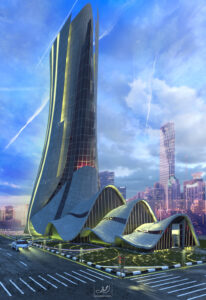Commercial Tower Construction : The Role of MEP in Modern Engineering

Commercial towers are the epitome of contemporary urban architecture—tall and proud as hubs of business, innovation, and infrastructure superiority. But hiding behind their glossy glass exteriors and towering heights is a complex system that makes everything tick. This unseen support comes in the form of MEP construction, which integrates Mechanical, Electrical, and Plumbing (MEP) systems to make all parts of the building work in harmony.
What is MEP in Construction?
MEP construction is the process of designing, installing, and servicing the Mechanical, Electrical, and Plumbing systems that give life to a building. These systems are essential in Commercial Towers since they govern the internal environment, maintain safety, and supply important utilities such as power, water, and ventilation.
In brief, MEP is the link between architectural design and functional performance. Without it, even the most visually appealing building would be impossible to live in.
Significance of MEP Services in Commercial Towers
MEP services are the key to the performance, comfort, and sustainability of commercial high-rises. Let us see how:
Mechanical Systems
Mechanical systems are concentrated on HVAC (Heating, Ventilation, and Air Conditioning)—the function of sustaining a comfortable indoor temperature, enhancing air quality, and controlling humidity. In high-rise commercial towers, sophisticated HVAC systems are crucial for maintaining uniform air circulation over several floors.
Electrical Systems
Electrical MEP design guarantees efficient power distribution, lighting, and interface with emergency systems. The electrical infrastructure of everything from elevators and lighting systems to data centers and office machines has to be efficient as well as safe.
Plumbing Systems
Plumbing encompasses all aspects ranging from water supply and drainage to fire protection systems. Adequate MEP civil engineering ensures the water and waste systems are structured to accommodate the requirements of hundreds—or thousands—of occupants.
MEP in Engineering: The Backbone of Smart Building Design
Today’s MEP systems do much more than serve functional utilities. They now incorporate smart technologies, energy-efficient systems, and green building designs.
Some of the major developments are :
Automation & IoT Integration – Sensors manage lighting, temperature, and ventilation for maximum efficiency.
Energy Efficiency – LED lighting, alternative energy sources, and high-efficiency HVAC cut power usage.
Sustainability – MEP engineers increasingly utilize green materials and water conservation strategies.
These advances render MEP engineering a key driver of green building certification and smart infrastructure construction.
MEP in Civil Engineering : The Perfect Coordination
MEP civil engineering requires synchronization between the MEP and civil teams at design and construction phases. In Commercial Towers, this coordination is essential to maintain:
Correct space planning for ducts, cables, and pipelines.
Structural integration of MEP elements with civil structures.
Optimized project schedules and less rework by using BIM (Building Information Modeling).
This coordinated effort ensures that the structural, electrical, mechanical, and plumbing systems function harmoniously together.
Advantages of Proper MEP Construction
Energy Savings : Streamlined MEP systems save on operational expenses.
Safety & Compliance : Proper installation guarantees compliance with building regulations and fire protection standards.
Sustainability : Encourages environmentally friendly operations and green certifications (LEED, IGBC, etc.).
Occupant Comfort : Adds to temperature control, lighting, and water supply reliability.
Reduced Maintenance Costs : Efficient design cuts down on system failures and repairs.
Conclusion
In the modern skyline of architectural wonders, commercial towers are not mere buildings—they are ecosystems fueled by MEP construction. The combination of mechanical, electrical, and plumbing engineering makes these towers safe, efficient, and sustainable.
From MEP services design to installation and maintenance, each aspect plays a role in designing commercial spaces that not only look amazing but also operate without a hitch for decades.


